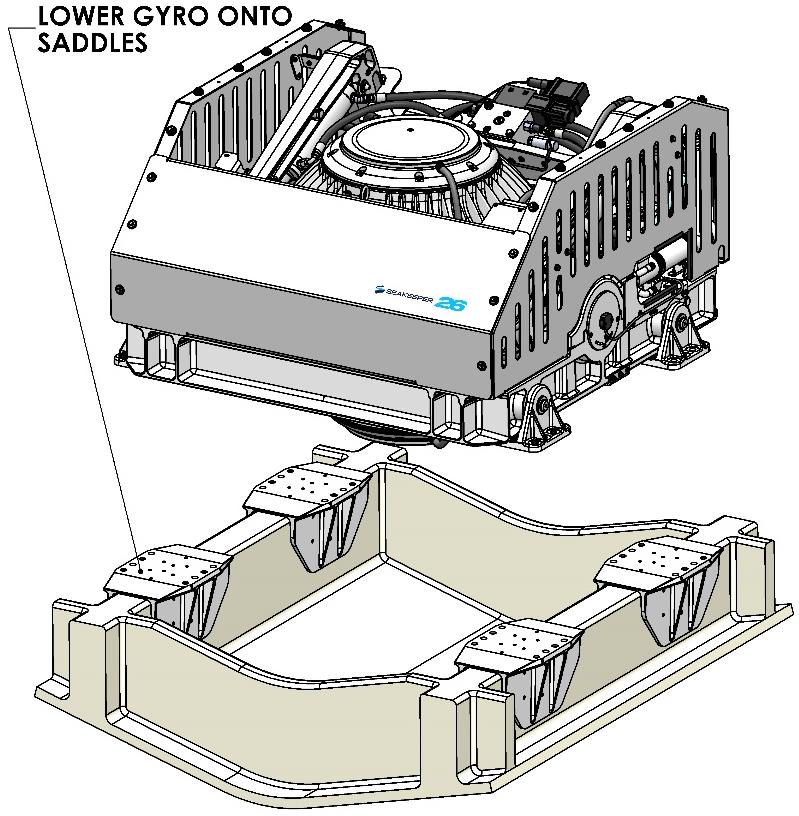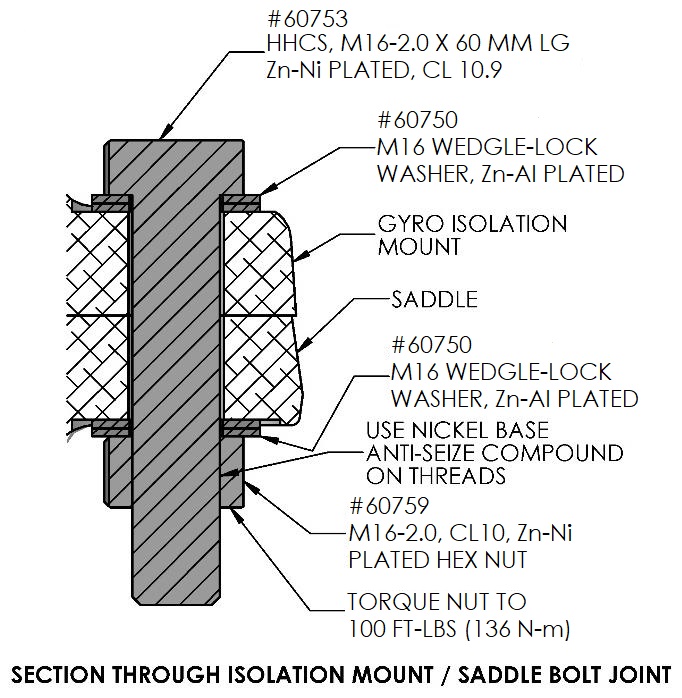Seakeeper 26 Installation Manual (90265-8); S/N 26-233-0690 to Current
2.0 Mechanical Installation
2.1 Mechanical Installation Introduction
The Seakeeper can produce loads up to 8,070 lbs (35.89 kN) at each of the four mounts. These forces should be considered to be acting simultaneously, fully reversing, and will repeat an infinite number of times. Careful consideration should be given to foundation design to ensure it is capable of transferring these loads into the hull. These loads do NOT include vessel motion accelerations, such as vertical slam loads which can be high for higher speed vessels. The responsible party for designing the supporting structure (boat builder, installer, or hired sub- contractor) must accommodate the above forces plus a reasonable factor of safety. Seakeeper recommends a minimum safety factor of 3.0 (yielding a Safety Margin of 2.0).
There are two methods of installing the Seakeeper 26:
1. Bolt-In Installation
2. Bond-In (Saddle) Installation
It is assumed that the installer is familiar with bonding using high strength adhesives or mechanical fasteners to marine structures and has performed structural analysis to assure the structure to which the Seakeeper mounts can properly transfer the loads the Seakeeper creates into the hull structure. If the installer has any doubt about the ability of the structure to transfer the loads to the hull, then a licensed naval architect or marine engineer should be contacted to do a structural analysis.
The installer should review the following list of reference drawings to ensure the installation procedure is fully understood.
Reference Documents & Drawings:
- 90271 – Seakeeper 26 Bolt-In Installation Guide
- 90272 – Seakeeper 26 Bond-In Installation Details
- 90085 – Seakeeper 26 Bond-In Saddle Kit
- 90086 – Seakeeper 26 Bolt-In Installation Kit, M16, Through-Bolt
- 90614 – Seakeeper 26 Bolt-In Installation Kit, M16, Blind-Hole
- 90088 – Seakeeper 26 Bond-In Installation Fixture Kit
- 90089 – Seakeeper 26 Bolt-In Installation Fixture Kit
2.2 Selection of Installation Location
Selection of mounting location of the Seakeeper should consider the following desirable features:

The Seakeeper should be installed aft of amidships to minimize high acceleration loadings due to hull/wave impacts during operation at high speed or in large waves. If the only possible installation location is forward of amidships, then the installer should have Seakeeper review the installation location prior to finalizing the design.
Seakeeper can only assess installation location regarding its impact on Seakeeper operation and serviceability. Seakeeper cannot determine how the installation location will affect the vessel static or directional stability other than cyclic roll reduction. The Installer is responsible for considering the Seakeeper’s effect on the CG location, trim, overall stability, and performance of the vessel.
The Installer is solely responsible for ensuring that the Seakeeper is properly located and installed on the vessel foundation with an adequate margin of safety for the specified design loads and vessel operating characteristics.
Selection of mounting location of the Seakeeper should consider the following desirable features:
- Adequate service access for scheduled maintenances and overhaul of the Seakeeper 26 is required. Overhead access or sufficient clearance for removal / re-installation of the Seakeeper for overhaul in future years. See Seakeeper drawing 90271 for special in-field bearing replacement clearances required.
- The Seakeeper should be installed in a dry space to minimize effects of corrosion.
- Clearance for all recommended scheduled maintenance and any repairs that may be necessary (see Figure 1).
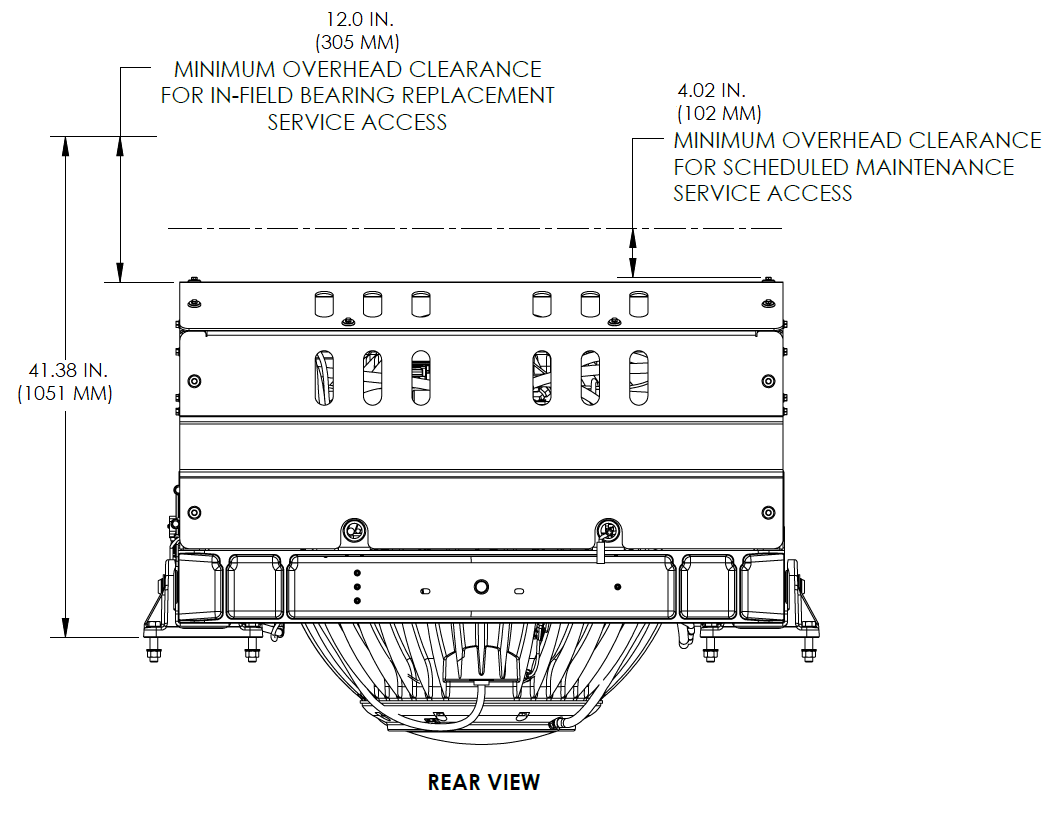
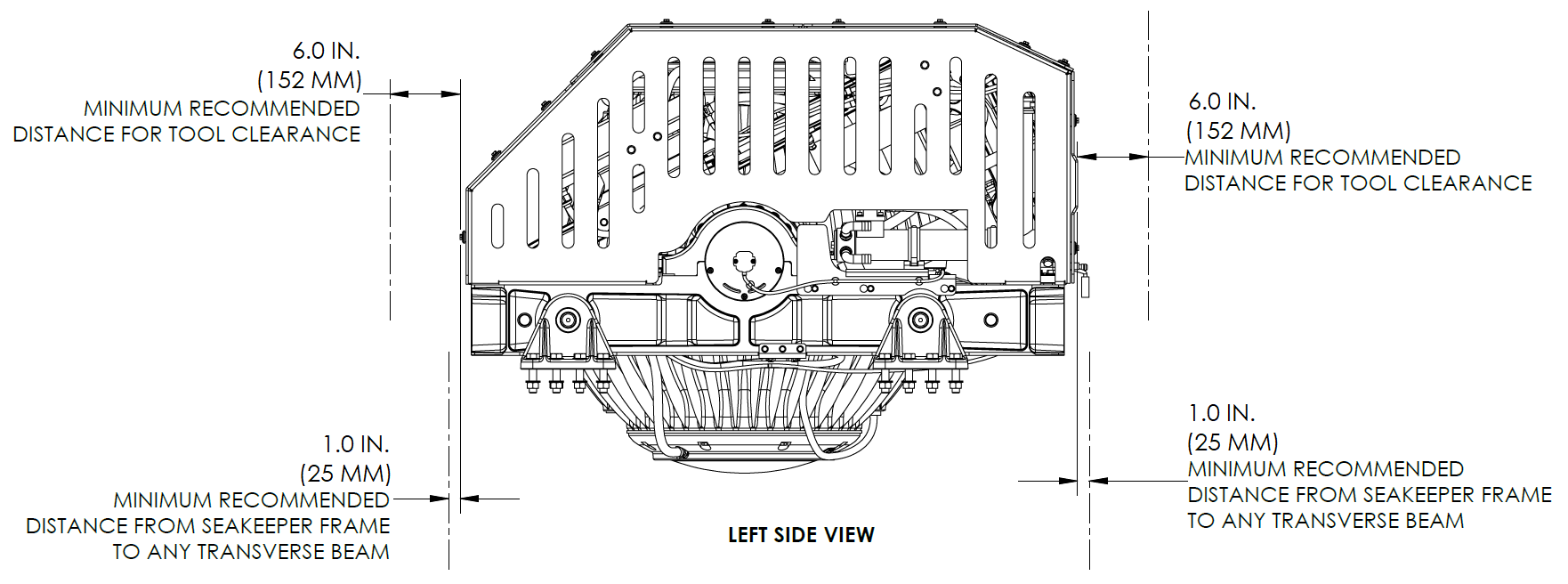
VIEWS SHOWING RECOMMENDED CLEARANCES AROUND THE SEAKEEPER FOR USE OF HANDTOOLS, EASE OF MAINTENANCE, INSTALLATION, AND PROPER OPERATION.
Figure 1 – Seakeeper 26 Installed Clearance Considerations
Noise/Soundproofing
Seakeeper noise has been measured under steady state conditions (no wave load) in Seakeeper‘s Engineering Lab and in our Factory Demo Boat. The steady state noise is typically < 74 dBC at 1 meter. As the frequencies emitting the highest sound pressures are low (like other marine machinery), it is recommended that the Seakeeper be installed in a machinery space that is already treated with soundproofing.
2.3 Selection of Installation Method
The Seakeeper 26 can be affixed to the hull structure using two methods 1) Bolt-In installation or 2) Bond-In (Saddle) installation. See figures below.

Option 1 would be applied when a metal structure is available for attachment. The foundation would fasten directly to hull structure using isolation gaskets and either M16 or 5/8 in. fasteners. Depending on the structure to which the Seakeeper is fastened, blind threaded holes or thru-bolting can be utilized.
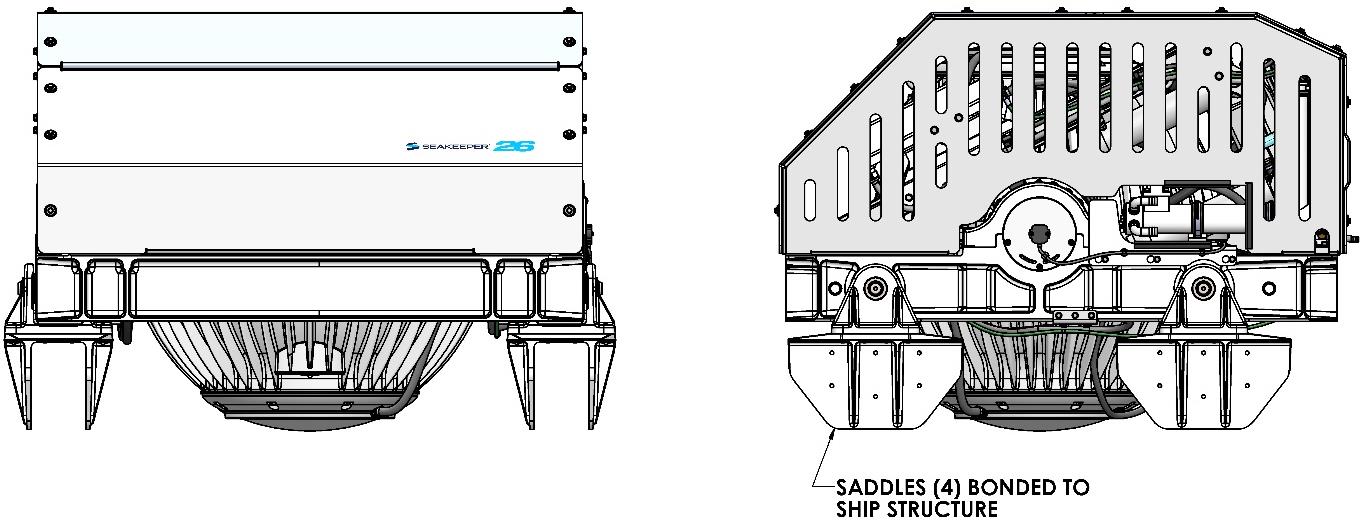
Option 2 would be commonly used on a hull constructed of glass reinforced plastic (GRP) or fiberglass. For this option, four 16 in. (406 mm) long by 8 in. (203 mm) deep saddles are bonded to properly spaced and prepared structural members that are an integral part of the hull structure. Seakeeper recommends using a structural adhesive with a lap shear strength of 2000 psi (13.8 MPa) or greater. Careful consideration should be exercised by the installer while selecting the appropriate adhesive. Compatibility with the Seakeeper’s cast aluminum A356-T6 saddles, hull structure and pot life are three important factors to consider. Proper surface preparation in accordance with adhesive manufacturer’s recommendations prior to installation is very important. Recommended adhesives can be found in Seakeeper Technical Bulletin 90382 – Structural Adhesive Recommendations.
2.4 Bolt-In Installation
2.4.1 Preparation of Vessel Structure
Seakeeper provided mounting hardware is intended to apply to typical installation arrangements. However, each installation, especially custom aftermarket foundations, should be thoroughly reviewed to ensure the provided hardware meets the required thread engagement for the Seakeeper unit being installed. The mounting bolt thread engagement requirements are outlined in the Installation Manuals and Installation Details Drawings for each Seakeeper model. This also applies to Seakeeper model adapter kits and OEM built frames where the bolt hole depth should be checked to ensure the bolts will not bottom, preventing the bolts from achieving the intended preload.
When the Seakeeper provided hardware is not appropriate, the bolt specification (diameter and thread pitch) and grade should be matched in the required length and used with the Seakeeper provided washers. Mounting bolts should always be torqued to the Seakeeper specification. All Seakeeper provided bolts are metric course thread. Hardware specifications are also listed in the Installation Manuals and Installation Details Drawings.
Refer to Seakeeper Drawing No. 90271 – Seakeeper 26 Bolt-In Installation Details. Important dimensional and load information is given in this drawing that will impact the design details of the structure that will receive the Seakeeper. It is assumed that a proper structural analysis has been performed for the hull structure to which the Seakeeper will be fastened to ensure proper strength margins for the loads the Seakeeper will create during operation. Seakeeper recommends a safety factor of 3.0.
Two bolt-in kits are available
1) Through-Bolt, reference Drawing No. 90086 – Seakeeper 26 Bolt-In Installation Kit, M16, Through-Bolt
2) Blind-Hole, reference Drawing No. 90614 – Seakeeper 26 Bolt-In Installation Kit, M16, Blind-Hole
The hull structure supporting the Seakeeper should be arranged so the Seakeeper is parallel to the water plane in the port-starboard and forward-aft directions . In addition, the four areas on top of the beams on which the feet of the isolation mounts will rest, need to be co-planar within 1/8 in. (3 mm) to minimize potential distortion of Seakeeper support frame when installed.
Seakeeper provides an installation fixture assembly (P/N 90089), which contains four plates that mimic the mating surfaces of the four isolation mounts located on the Seakeeper’s foundation. These plates have 8 holes located at the same centers as the holes in the isolation mounts. These smaller holes can be used to locate the holes in the ship’s structure through use of a transfer punch. The fixture locates the hole patterns at the proper spacing, both in the fore-aft direction and the port-starboard direction. See Figures 2 & 3 below. Once assembled, the fixture can be used to check clearances and alignment of the hull structure.
Note: Do NOT use the installation fixture to establish Seakeeper envelope dimensions. Refer to Drawing No. 90271 – Seakeeper 26 Bolt-In Installation Details, for envelope dimensions. A 3-D model of the Seakeeper is available on the Seakeeper website (www.seakeeper.com) to aid in designing the Seakeeper foundation and the space around the Seakeeper.
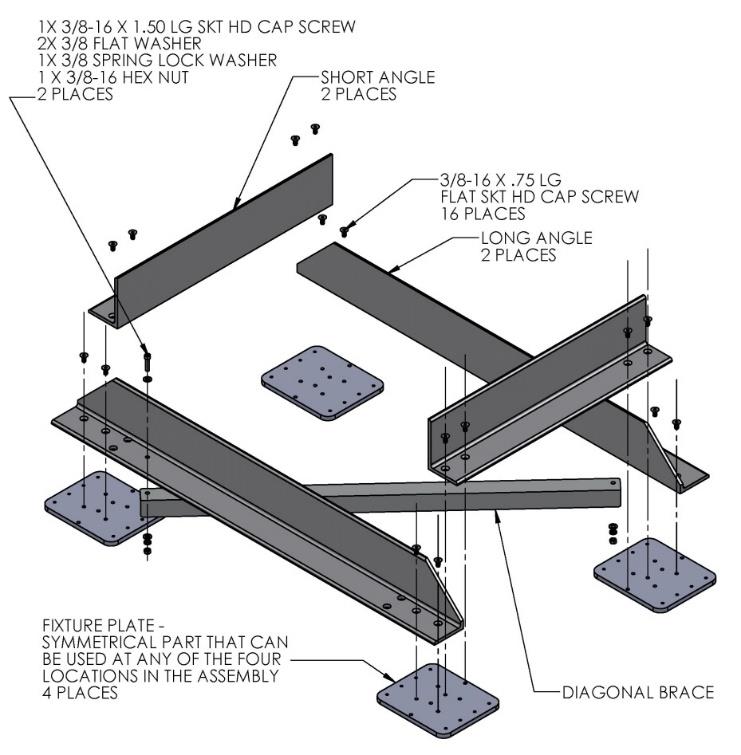

2.4.2 Transfer of Holes to Boat Structure
- Lower assembled fixture onto hull structure.
- The four areas where the isolation mounts will rest should be coplanar to within 1/8 in. (3 mm). See figure below. Do not use the fixture to check co-planarity as it is not stiff enough.
- Align fixture in desired location and transfer holes from fixture plate to the hull structure. A transfer punch is recommended for this step. Note that holes in fixture plate are ø.257 in. (6.5 mm).
- Remove fixture and drill holes in foundation at marked locations to mate with holes in Seakeeper isolation mounts. A ø.689 in. (17.5 mm) hole is recommended for through-bolt installations.
NOTE: Certain foundation designs that employ threaded blind holes in thick plates may require the installer to obtain alternate fasteners. Reference Drawing No. 90614 – Seakeeper 26 Bolt-In Installation Kit, M16, Blind-Hole.
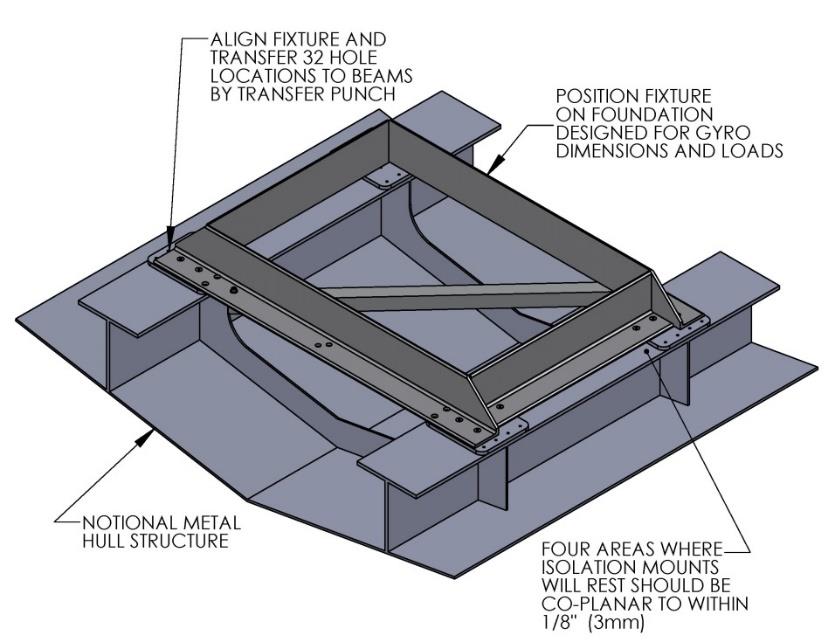

2.4.3 Installation of Seakeeper
- Locate and position 4 isolation gaskets onto foundation beams (for metal to metal contacts only).
NOTE: A VERY SMALL AMOUNT OF SEALANT MAY BE APPLIED TO THE GASKET TO KEEP WATER FROM WICKING INTO THE JOINT. Isolation gaskets are only required when mounting to a structure other than aluminum or GRP. - Lower Seakeeper into position onto foundation beams and align over drilled holes.
- Install Mounting Bolts:
- For Through-Hole installation (P/N 90086 – Seakeeper 26 Thru-Bolt Kit), install the Seakeeper supplied M16 fasteners as shown in figure below to maintain a minimum of two (2) threads protruding past nut. Apply a moderate coat of nickel-based anti-seize(e.g., SAF-T-EZE nickel grade anti-seize, SBT-4N or equivalent) to the threads of each bolt and include a small bead of marine grade sealant (e.g., SILI-THANE 803or equivalent) under each bolt head and washer before installation. See Figure 4 below.
- For Blind-Hole installations (P/N 90614 – Seakeeper 26 Bolt-In Kit), install the Seakeeper supplied M16 fasteners as shown in figure below to maintain a minimum thread engagement of 0.89 in. (23 mm). Apply a moderate coat of nickel-based anti-seize(e.g., SAF-T-EZE nickel grade anti-seize, SBT-4N or equivalent) to the threads of each bolt and include a small bead of marine grade sealant (e.g., SILI-THANE 803 or equivalent) under each bolt head and washer before installation. See Figure 5 below.
- Torque all fasteners to 100 ft-lbs (136 N-m).
- New bolts matching the Seakeeper specification must be used for each installation and reinstallation that meet the requirements listed above.
- Proceed to electrical and cooling portion of the installation.

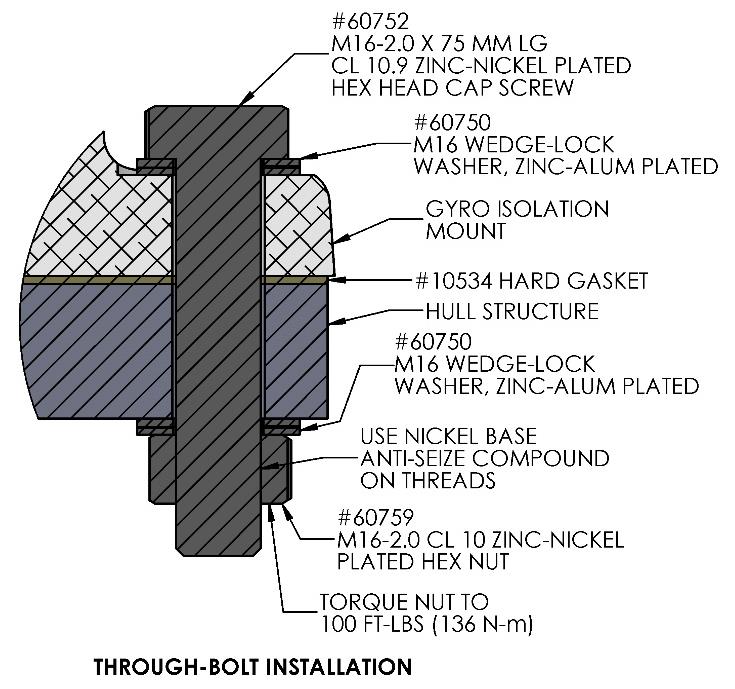

2.5 Saddle Installation
2.5.1 Saddle Installation Introduction
Seakeeper recommended adhesives are listed in TB-90382 – Structural Adhesives Recommendations. Seakeeper recommends using a structural adhesive with a lap shear strength of 2000 psi (13.8 MPa) or greater. Careful consideration should be exercised by the installer when selecting the appropriate adhesive, such as working time, material compatibility, and surface preparation are three important factors to consider. Proper surface preparation in accordance with the adhesive manufacturer’s recommendations prior to installation is critically important. Information regarding pot-life, structural properties and material compatibility can be found on the adhesive product’s technical data sheet (TDS). An etching/cleaning primer compatible with the adhesive should be used on all aluminum surfaces if recommended by the manufacturer. Typically, two-part methacrylate based adhesives are the best options for bond-in installations such as Plexus MA590 and Sci-GripSG300, which provide compatibility with aluminum and FRP substrates, adequate working time, and exceed the strength requirements. See Seakeeper Drawing No. 90272 – Seakeeper 26 Bond-In Installation Details, for further information.
2.5.2 Preparation of Vessel Structure
Refer to Seakeeper Drawing No. 90272 – Seakeeper 26 Bond-In Installation Details. Important dimensional and load information is given in this drawing that will impact the design details of the structure that will receive the Seakeeper as well as selection of the adhesive to bond the Seakeeper into the hull.
The foundation “saddles” of the Seakeeper are designed to be bonded directly to the composite hull structure of the vessel to effectively distribute Seakeeper loads. A complete bond is required between the inside surface of the saddles and the hull structure. Seakeeper recommends having a minimum of 2.4 L / 0.6 gal of adhesive on hand for installation. Some adhesives require etching primer for aluminum surfaces (Plexus MA590 requires PC120 primer). Both manual and pneumatic application guns are available from adhesive manufacturers. Two workers should apply the adhesive at the same time to finish the installation before the adhesive starts to cure. To aid in determining the quantity of adhesive required, the interior surface area (bonding surfaces) of each saddle is 287 in.2 (1,852 cm2) for a total bonded surface area for all four saddles of 1,148 in.2 (7,406 cm2).
The hull structure supporting the Seakeeper should be arranged so the Seakeeper is parallel to the water plane in the port-starboard and forward-aft directions. In addition, the four areas on top of the beams that the saddles will bond to need to be co-planar within 1/8 in. (3 mm) to minimize potential distortion of Seakeeper support frame when installed. The four areas on top of the saddles on which the feet of the Seakeeper foundation rest must be coplanar within 0.6 in. (1.5 mm) to minimize potential distortion of Seakeeper support frame when installed.
Note that any paint or gel-coat present in bond area should be removed so that adhesive will bond directly to laminate fibers and resin. Fiberglass and aluminum surfaces should be sanded in cross-hatch pattern with 80-grit sandpaper and thoroughly cleaned prior to adhesive application.
Seakeeper provides an installation fixture template (P/N 90088), that locates the saddles at the proper spacing both in the port-starboard and the forward-aft direction direction. See Figures 6, 7 & 8 below. Once assembled with the provided saddle fittings, the fixture can be used to check clearances and alignment of the hull structure. The fixture will allow the builder / installer to lay-up and adjust the foundation dimensions to create a low-clearance fit between the Seakeeper foundation saddles and the hull structure. Shear strength of the adhesive will be maximized if the cured thickness between the vessel structure and the Seakeeper saddles is at the thinner end of the adhesive manufacturer’s recommended range. Therefore, the fixture should be used to confirm that the overall dimensions of the foundations are square and level and that the adhesive gap is within Seakeeper’s recommended range of .04 in. to .13 in. (1 to 3 mm).
Note: Do NOT use the installation fixture to establish Seakeeper envelope dimensions. Refer to Drawing No. 90272 – Seakeeper 26 Bond-In Installation Details, for envelope dimensions. A 3-D model of the Seakeeper is available on the Seakeeper website (www.seakeeper.com) to aid in designing the Seakeeper foundation and the space around the Seakeeper.
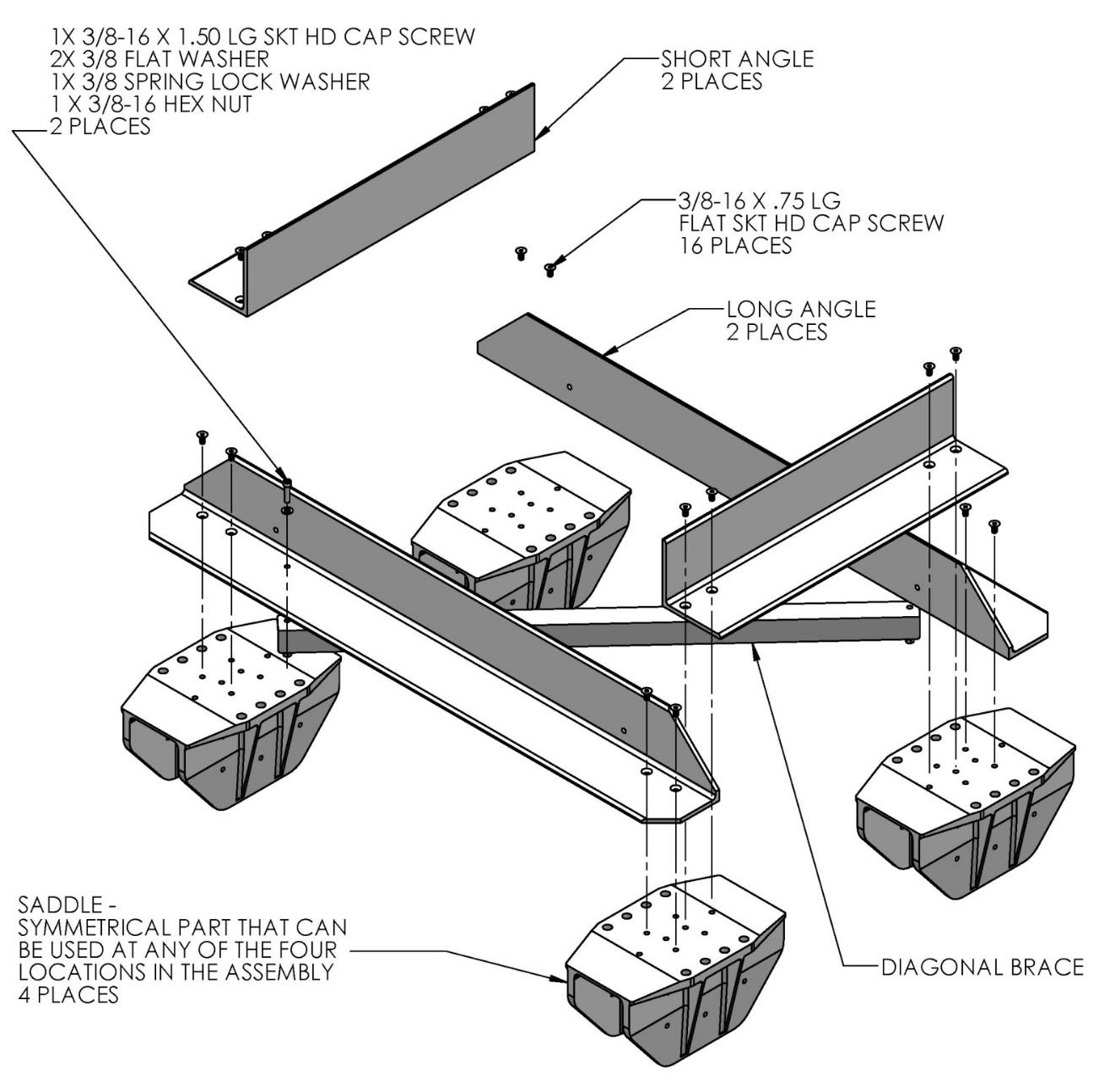
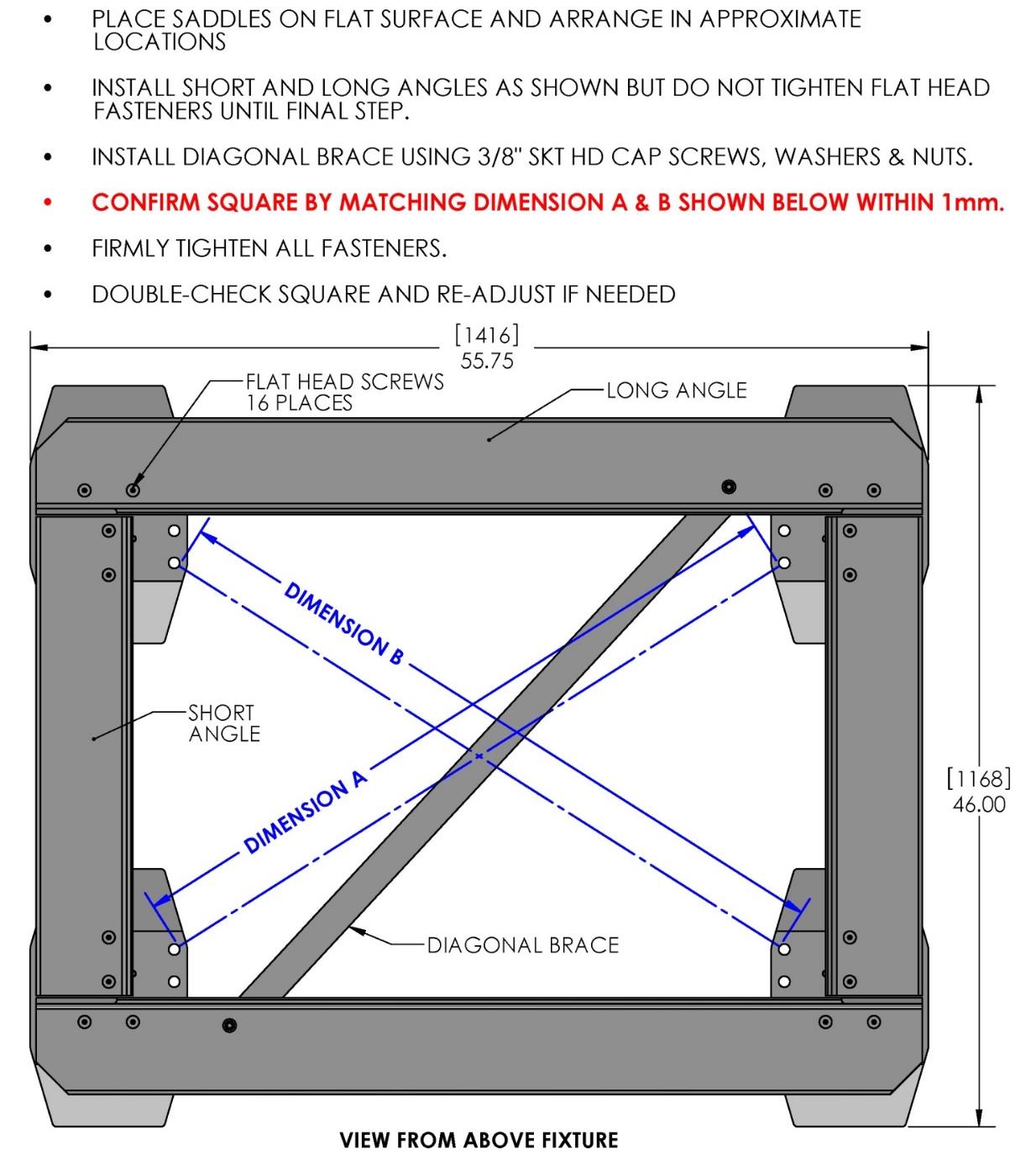
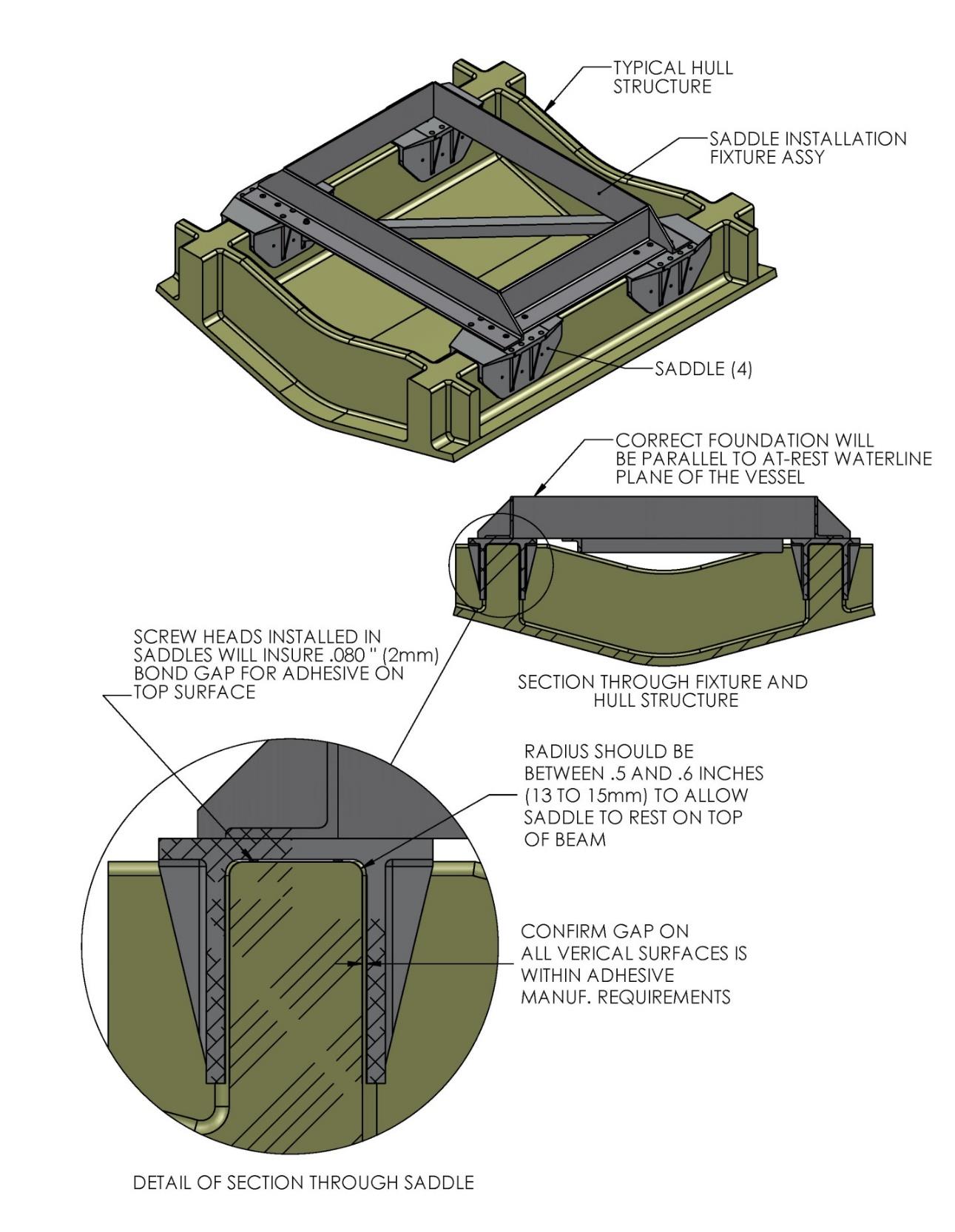
2.5.3 Fiberglass Hull Preparation
- Position installation fixture (Figure 9) on hull girders noting recommended clearances for maintenance from Figure 2 (in Section: Selection of Installation Location). Check that the screws fastening the saddles to the installation fixture are tight (Figure 7).
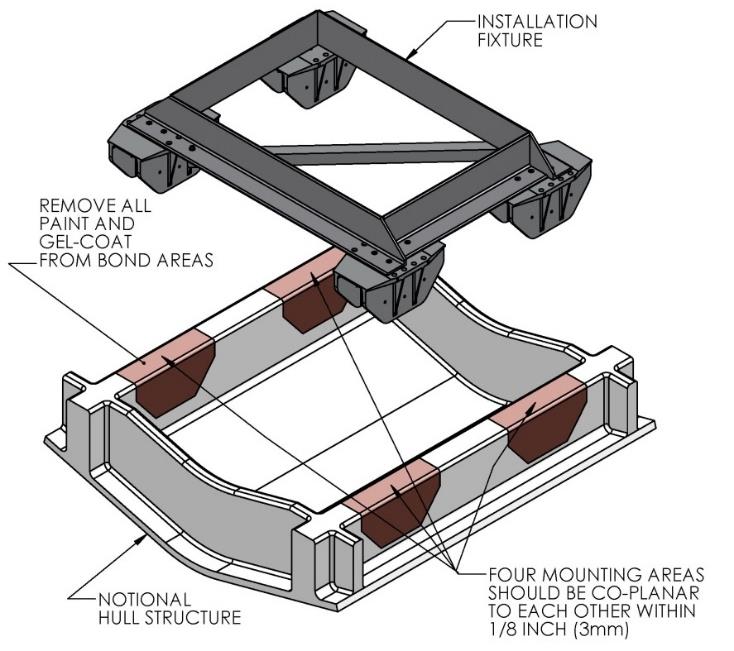
- Mask hull area (as shown in blue, Figure 10) around foundation saddles for easy clean-up and to create an outline of surface area to receive adhesive as shown in brown (Figure 9). Ensure that the bond gap is within adhesive manufacturer’s recommended thickness, or 3 mm if using Plexus MA590 or Sci-Grip SG300.
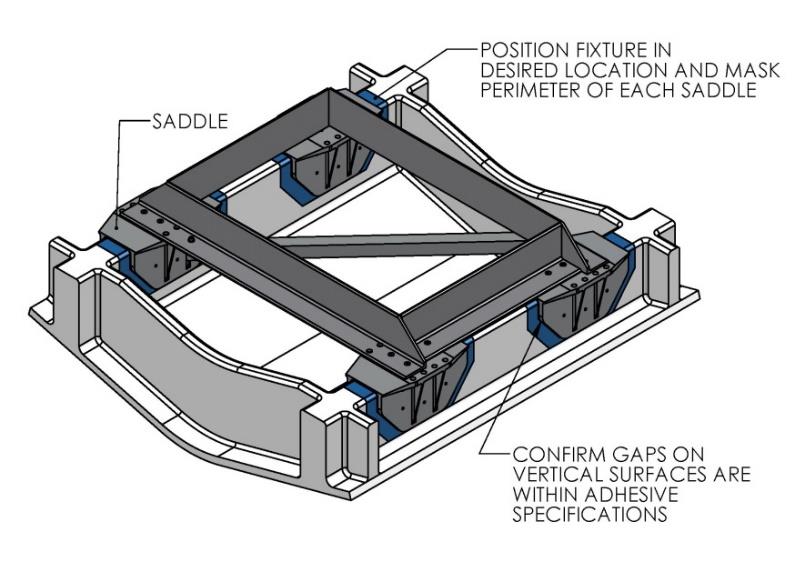
- Raise fixture clear of foundation. Check all four mounting areas are co-planar to within 1/8 in. (3 mm) to each other, as well as parallel to the water line plane, as shown in Figure 11.
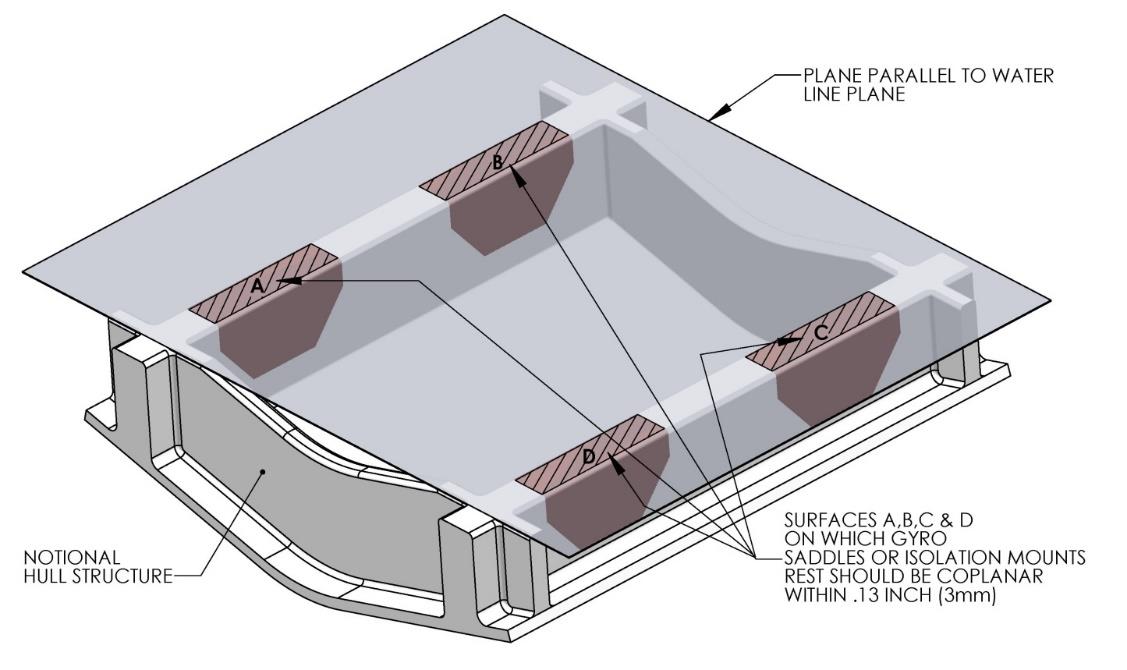
- Thoroughly clean with alcohol or acetone all areas (highlighted in brown, Figure 9) of girders to be bonded to remove any contaminates. Use new paper towels for cleaning, not shop rags.
- Remove any paint or gel-coat from bond surfaces so that adhesive will bond directly to laminate fibers and resin.
- Thoroughly sand girder bond surfaces with 80 grit sandpaper in cross-hatch pattern. (IMPORTANT – BOND STRENGTH MAY BE REDUCED IF THIS STEP IS SKIPPED.)
- Wipe surfaces clean from dust with alcohol or acetone using new paper towels, not shop rags.
- Re-position installation fixture on girders and double-check that the adhesive gap is within the adhesive manufacturer’s maximum recommended thickness. (Note gap will be larger due to absence of gel-coat.) Seakeeper recommends a maximum gap of 3 mm if using Plexus MA590 or Sci-Grip SG300.
- Lift installation fixture clear of foundation. Apply Seakeeper provided adhesive backed foam strips at the eight locations shown (each end of four saddles) in Figure 12 below. These strips are to serve as a dam to minimize adhesive escaping out the ends of the saddles as they are positioned over the bond area.
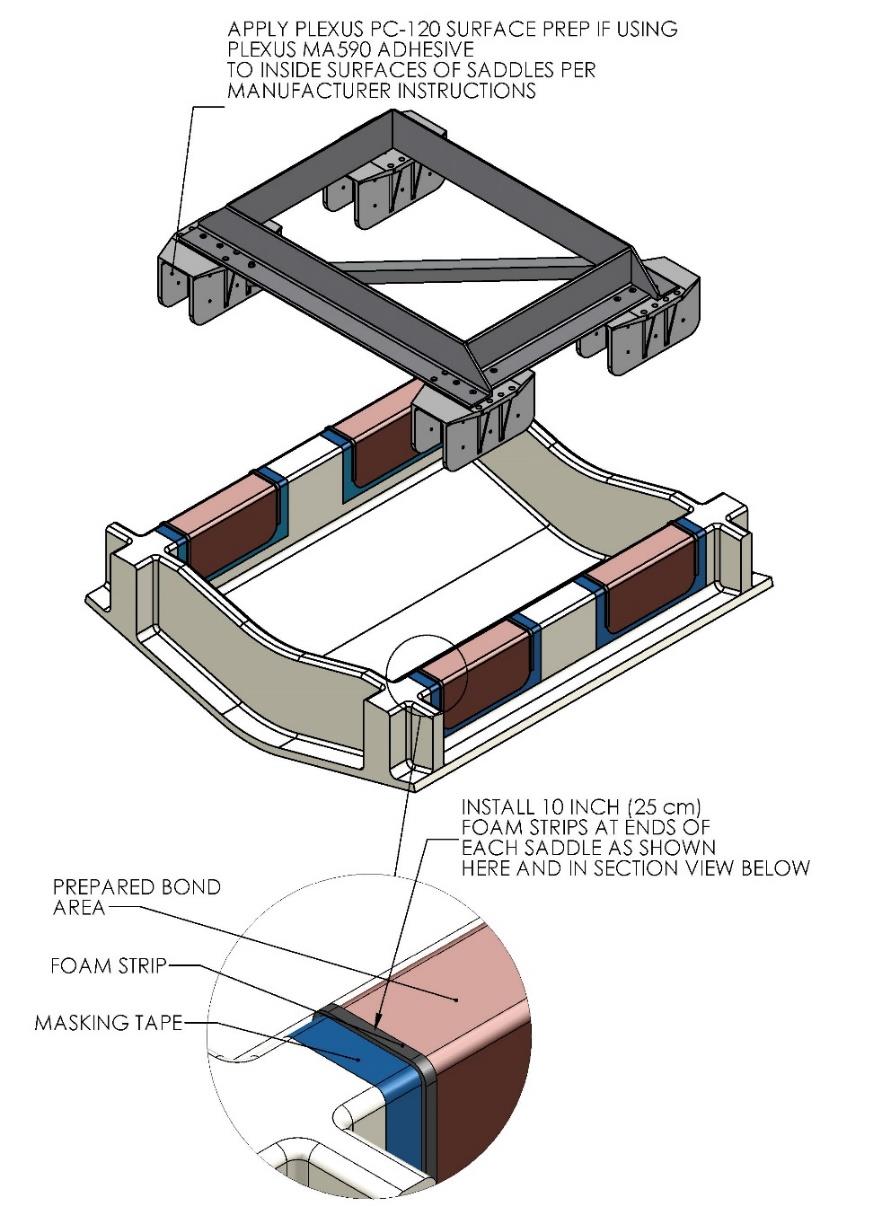

Note: If bonding saddles to a non-composite hull, contact Seakeeper for hull preparation instructions.
2.5.4 Seakeeper Saddle Preparation
- Ensure that screws fastening saddles to the installation fixture are tight (Figure 7).
- Check that each saddle contains 4 plastic screws which will ensure an adhesive gap of .080 in. (2 mm) on top surface of hull as shown in Figure 13. Do not remove these screws.
- Thoroughly clean with alcohol or acetone the inside surfaces of Seakeeper foundation saddles to remove any contaminates as shown in Figure 13. Use new paper towels for cleaning, not shop rags.

- Thoroughly sand all saddle inside surfaces with 80 grit sandpaper in a cross-hatch pattern. (IMPORTANT – BOND STRENGTH MAY BE REDUCED IF THIS STEP IS SKIPPED.)
- Wipe surfaces clean from dust with alcohol or acetone using new paper towels, not shop rags.
- If using Plexus MA590 adhesive, apply Plexus PC-120 surface conditioner to inside surfaces of Seakeeper foundation saddles in accordance with manufacturer instructions. These instructions are located at the end of this section. If using an alternate adhesive, check with manufacturer if any surface conditioner/etch is required for the aluminum saddles.
2.5.5 Bonding Saddles to Hull
Note: This is a sample if using Plexus, if using another adhesive follow manufacturer’s recommendations.
If using Plexus MA590 adhesive, the Seakeeper saddles should be installed when PC-120 is confirmed dry.
- Assemble Plexus cartridge into either the manual or pneumatic gun as shown. Remove cap on cartridge and attach mixing tip. For pneumatic gun, start with low air pressure and increase until desired flow rate is achieved.
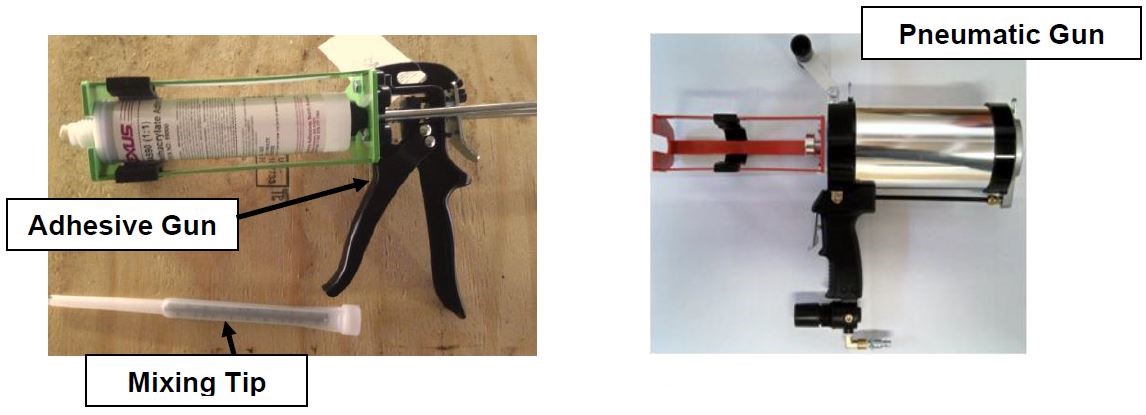
- Cut tip of mixing wand as shown in photo below.
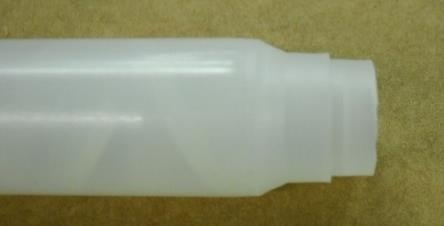
- Prepare a second mixing wand as shown in photo below by attaching the simple flexible nozzle to the end of the mixing tip. Set aside for now as this will be used to inject adhesive into the sides of each saddle after the fixture / saddles are in position.

- Install provided rubber plugs in 12 holes of each saddle. The plugs will limit the adhesive being forced out of the injection holes in step 6 below.
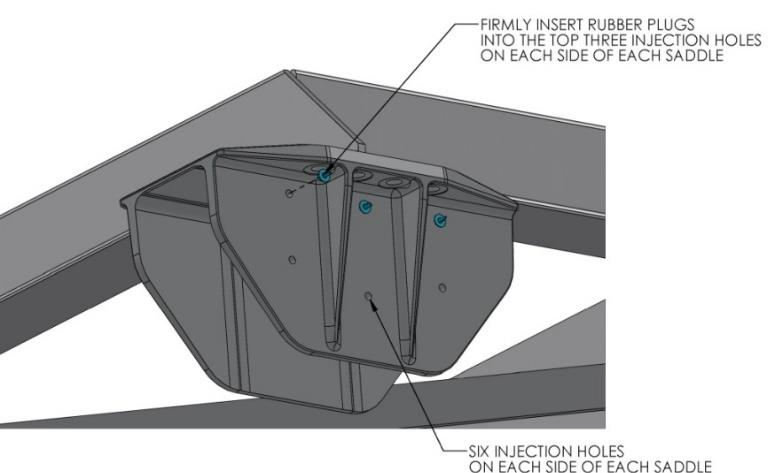
- Apply large bead of Plexus adhesive to the hull structure as shown in the figure below. Apply approximately 350 mL at each of the four locations (the adhesive should completely fill the gap between the hull structure and Seakeeper saddles, and generate squeeze out along the sides when the saddles are placed onto the structure). Work deliberate and fast as it takes some time to apply the adhesive to the structure. MA590 has a 90-minute working time at room temperature (73°F / 23°C). This working time can reduce to 40-50 minutes at elevated temperatures. Two workers should apply the adhesive at the same time to finish the installation before the adhesive starts to cure.

- Lower fixture and saddles over the hull structure and apply light downward pressure to each of the four saddles until the four nylon screws rest on the hull structure (see Figure 9). The adhesive will be forced towards the forward and aft ends of each saddle and partially down the sides of the foundation beams.
- Insert full adhesive cartridge along with mixing wand / nozzle assembled in Step 3 above, into gun.
- Begin to inject adhesive into the six holes provided on each side of each of the four saddles. Follow the numbered sequence shown until the adhesive pushes out the edges of the saddle perimeter. The intent is to pump in the adhesive working from the top down and from the middle to the ends to fill the gaps and displace any air. A complete bond is required – excess adhesive will be needed to make sure all bond gaps are filled.
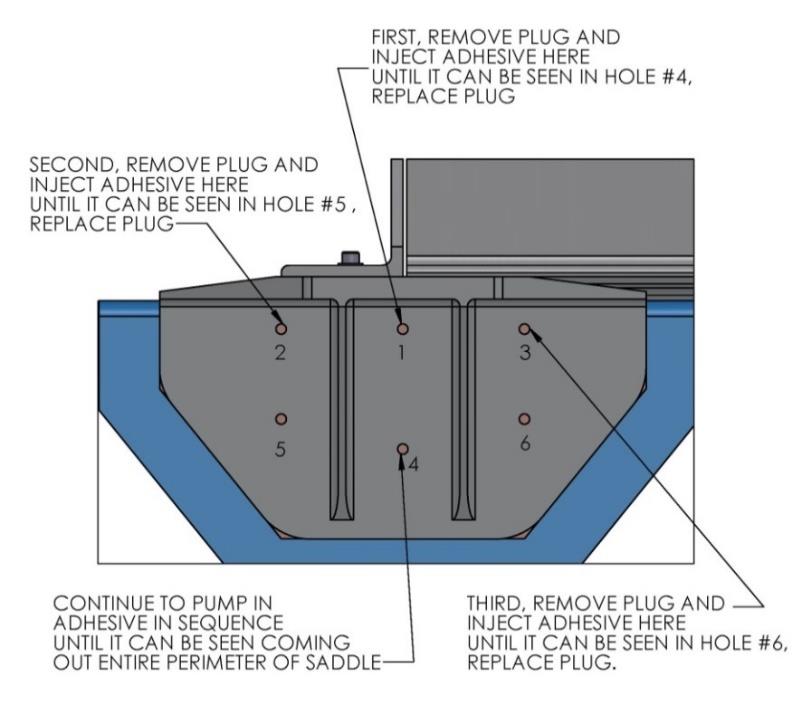
- Repeat above step for remaining 7 sides of the saddles.
- When gaps have been completely filled, clean off excess adhesive, remove foam tape, remove plugs, and remove masking tape.
- Allow adhesive to cure per manufacturer’s recommendations. Follow adhesive guidelines for curing time versus temperature prior to removing the fixture.
- Bonding of Seakeeper saddles onto the hull is now complete. Remove installation fixture.
2.5.6 Installation of Seakeeper
- Rig Seakeeper for lifting and lower it into position onto top surface of four saddles.
- Adjust position of the Seakeeper until alignment is achieved for the 32 fasteners that will attach the Seakeeper foundation frame to saddles.
- Install Seakeeper supplied M16 fasteners as shown in figure below – apply a moderate coat of nickel based anti-seize compound to the threads of each bolt prior to installation.
- Torque all fasteners to 100 ft-lbs (136 N-m).
- Apply a small bead of sealant (silicone or caulk) around the perimeter of each isolation mount where it rests on the saddle. This will prevent water from wicking between the parts and setting up corrosion.
- Proceed to electrical and cooling portion of the installation.
